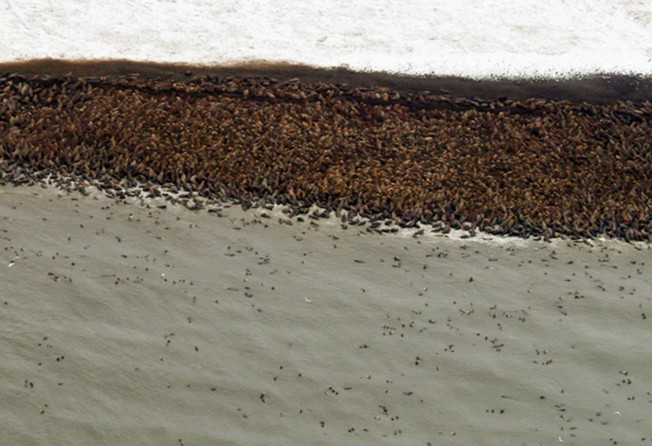
Shrinking sea ice forces walruses to crowd onto remote Alaskan beach
Thousands of the mammals pack a rocky shoreline in Alaska, victims of warming climate

An estimated 10,000 walruses unable to find sea ice over shallow Arctic Ocean water have come ashore on Alaska's northwest coast.

Walruses have been coming ashore since mid-September. The large herd was spotted during the administration's annual arctic marine mammal aerial survey, an effort conducted with the Bureau of Ocean Energy Management, the agency that conducts offshore lease sales.
An estimated 2,000 to 4,000 walruses were photographed at the site on September 12. The US Fish and Wildlife Service, the agency that manages walruses, immediately took steps to prevent a stampede among the animals packed shoulder to shoulder on the rocky coastline. The agency works with villages to keep people and aircraft a safe distance from herds.
Young animals are especially vulnerable to stampedes triggered by a polar bear, a human hunter or a low-flying aeroplane. The carcasses of more than 130 mostly young walruses were counted after a stampede in September 2009 at Alaska's Icy Cape.
The gathering of walruses on shore is a phenomenon that has accompanied the loss of summer sea ice amid a warming climate.
Pacific walruses spend winters in the Bering Sea. Females give birth on sea ice and use ice as a diving platform to reach snails, clams and worms on the shallow continental shelf.
As temperatures warm in summer, the edge of the sea ice recedes north. Females and their young ride the edge of the sea ice into the Chukchi Sea. However, in recent years, sea ice has receded north beyond continental shelf waters and into Arctic Ocean water 3,000 metres deep or more where walruses cannot dive to the bottom to feed.
Walruses in large numbers were first spotted on the US side of the Chukchi Sea in 2007. They returned in 2009. In 2011, scientists estimated there were 30,000 walruses along one kilometre of beach near Point Lay.
Remnant ice kept walruses offshore in 2008 and again last year.
The goal of the marine mammals survey is to record the abundance of bowhead, gray, minke, fin and beluga whales plus other marine mammals in areas of potential oil and natural gas development, said NOAA Fisheries marine mammal scientist Megan Ferguson.
Environmental groups say the loss of sea ice due to climate warming is harming marine mammals, and oil and gas development would add to their stress.